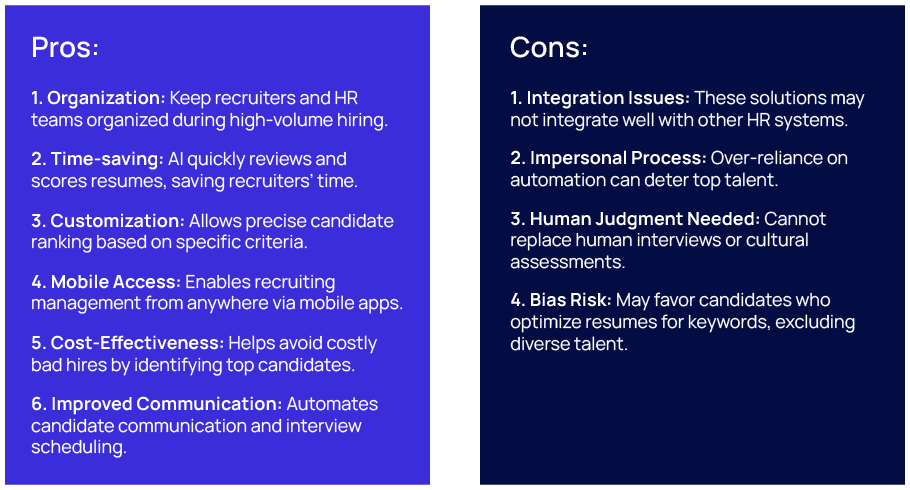According to recent staffing industry research, 53% of staffing professionals report that job boards are losing their effectiveness. Also, staffing firms are struggling to attract qualified candidates. In fact, hiring a new employee has become increasingly expensive and time-consuming. Moreover, recruiters are stating that costs are at an all-time high due to the tight job market.
Depending on the job level, the hiring process can take 32 to 68 days. This inefficiency affects everyone involved in the process, including recruiters, candidates, hiring managers, and organizational leaders, all of whom are seeking a quicker and more streamlined process. Additionally, it is reported that 61% of candidates now have higher expectations from recruiters. Fortunately, technological advances, especially AI-driven automation in recruiting, offer talent teams the tools to address these challenges and enhance the entire hiring process.
In today’s highly competitive job market, talent shortage has become more critical than ever, with recruiters and companies competing for a limited number of skilled professionals. Besides, traditional recruitment methods often fall short, leading to prolonged hiring processes resulting in missed opportunities for securing top talent. Along with that, the complexities of aligning specific skills with job requirements have traditionally been time-consuming and prone to errors. Therefore, in the last few years, recruiting automation has become one of the major focus areas for talent acquisition professionals. It’s revolutionizing the hiring landscape by tackling long-standing challenges with a modern, technology-based approach. Automation brings a new level of precision and efficiency, as well as changing the way companies manage these tasks in general.
Beyond streamlining logistics, automation is also vital in transforming the candidate experience and fostering more equitable and inclusive hiring practices. In fact, AI-driven, data-centric recruitment accelerates the hiring process and enhances accuracy by making decisions based on objective data rather than personal biases. This is especially critical in promoting diversity, equity, and inclusion (DEI), where the threat of unconscious bias has been a significant concern historically. By addressing essential challenges such as reducing the time to hire and enhancing skill matching, recruitment process automation goes beyond process optimization. It is reshaping the hiring process into a more efficient, fair, and candidate-focused landscape.
Modern Recruitment Solutions
Here’s a closer look at how modern solutions enhance recruitment efficiency.
1. Resume Skill Matching
The integration of AI technologies, especially machine learning algorithms, has revolutionized resume screening, making it more efficient and accurate. Modern automated systems have the capability to analyze a vast number of resumes, identifying relevant keywords, skills, and experiences that align with specific job descriptions. Moreover, by employing natural language processing (NLP), these AI algorithms can grasp the context within resumes, resulting in more precise candidate matching.
AI resume screening operates through several key processes, including:
- Data parsing to extract vital information such as education and work experience
- Keyword analysis to match candidates with job requirements
- Semantic understanding to interpret the meaning behind words
- Pattern recognition to identify trends based on previous successful hires
Automation not only accelerates the recruitment process by reducing the time spent on initial resume reviews but also improves accuracy by minimizing biases and errors caused by humans. Moreover, it enhances the candidate experience through prompt feedback and offers significant cost savings by streamlining administrative tasks.
AI-driven resume screening is a major leap forward in recruitment technology, which is transforming how organizations find and evaluate talent. Recruiters can now make more informed decisions by automating repetitive tasks and harnessing AI capabilities.
2. Customized Messaging
Statistics show that 47% of job seekers prefer receiving targeted job opportunities via text. It also states that 60% of employers already engage in text messaging with candidates. As potential candidates are often overwhelmed with emails, DMs, and app notifications, text messaging offers a direct and efficient communication channel that cuts through the noise. In fact, recruiters can streamline the hiring process by utilizing technology and automation through text message templates and adhering to best practices such as timing and consent guidelines. Thus ensuring consistency, efficiency, and a seamless interaction with the candidates. This approach not only accelerates communication but also enhances engagement and reduces no-shows. Moreover, it helps keep the candidates informed and involved throughout the recruitment journey, ultimately leading to better hiring outcomes.
3. Candidate Experience Platforms
Contrary to traditional processes that overwhelm the hiring teams with manual coordination, candidate experience platforms provide a centralized hub where candidates can access everything they need. This includes employer branding content, interview preparation materials, and employee profiles and interview schedules. All are integrated seamlessly with the organization’s applicant tracking system (ATS). This offers transparency that allows candidates to see where they are in the process, enhancing their experience and reducing frustration. Technology plays a crucial role in automating communication to keep candidates engaged with timely updates on their application status, interview schedules, and other relevant information. Furthermore, the platform can drive continuous improvement by identifying weak areas and measuring the impact of initiatives. Therefore, with the integration of technology, the system can also speed up the recruitment process by analyzing resumes, assessing candidate suitability, and conducting initial screenings as well.
4. Sentiment Analytics
In recruitment, sentiment analysis tools evaluate textual data from resumes and cover letters, identifying positive or negative sentiments to gauge a candidate’s enthusiasm and professionalism. Today, AI-driven sentiment analysis is transforming HR practices by offering nuanced insights into both recruitment and employee engagement. Social media analysis further enriches this assessment by providing a broader view of a candidate’s personality and public behavior, helping to determine the cultural fit. Besides, technology also improves the candidate experience by analyzing the feedback and communication tone throughout the hiring process. This allows the HR professionals to address pain points and foster a more positive interaction. Moreover, sentiment analysis reduces bias by offering objective evaluations of candidates, thus promoting a more merit-based and equitable hiring process. This comprehensive approach enhances decision-making and drives more effective recruitment strategies.
5. Employee Training, L&D, Particularly Language Skills Focused Courses
Recruitment automation can be effectively integrated with employee training (learning) and development (L&D) programs, particularly in areas like language skills, which are crucial in today’s globalized workforce. Technology can help bridge the gap between a new hire’s skills and those required for their role by recommending tailored training programs during the onboarding process.
For instance, if a candidate’s resume reveals that they have only basic proficiency in a certain language that is critical for their role, the system could automatically suggest a specific course as part of their initial training. Thus, the onboarding process can be accelerated helping ensure that employees are equipped with the necessary skills from the outset. Moreover, as employees progress in their roles, the system can continue to assess their development needs and recommend suitable ongoing training programs, thereby supporting continuous learning and development.
Language skills, in particular, can benefit from this approach because automated assessments can precisely gauge a candidate’s proficiency level and identify specific areas that need improvement. However, while automation can streamline and enhance the training process, organizations should be mindful that it should not replace the human element entirely. Language acquisition, for example, often requires cultural immersion, conversational practice, and mentorship. These elements are difficult to replicate through automated platforms alone. Therefore, a balanced approach, where automated tools are used to assess and recommend, but human trainers and mentors deliver the nuanced aspects of learning, would provide the most effective results.
Apart from this, a lot of learning and development material can be automated using Generative AI. Generative AI can be highly useful in automating the creation of job descriptions, pre-screening questions, and communication materials by analyzing job requirements and candidate profiles. The AI algorithms identify vital skills and qualifications needed for each role and generate precise, engaging content accordingly. This process involves generating and refining text for job postings, crafting personalized email and text message templates, and suggesting improvements based on historical data and candidate interactions. Thus resulting in more effective job postings, enhanced recruiter-candidate communication, and a streamlined recruitment process.
The Benefits and Drawbacks of Modern Recruitment Solutions
Like a coin, even HR technology has two sides, and in order to make an informed decision, it is crucial to weigh both facets of tech solutions for the staffing industry. Listed below are the pros and cons of modern recruitment solutions:

Embracing The Human Element
Today, while automated recruiting software has made significant strides within every industry, recruiters also agree that it still has room for improvement before it can be considered fully efficient. In the meantime, it’s essential for HR professionals to remain actively engaged in the hiring process. Hence, human interactions and connections are irreplaceable as automation cannot replicate the value these bring. Also, candidates feel more valued when we preserve the human element in recruiting, which positively impacts their mental and emotional well-being.
Moreover, when recruiters take the time to get to know candidates personally, they often uncover unique qualities—such as unexpected hobbies or experiences—that go beyond what a conventional resume can convey.
Often, machines scanning resumes may overlook valuable information unless they are specifically programmed to recognize it. Thus, highlighting the need for human intervention to maintain a diverse talent pool. To enhance the recruiting process, HR professionals should anonymize candidate resumes before sharing them with hiring managers. Moreover, by removing personal details such as names and other identifiable information, bias can be minimized, allowing recruiters to focus on the skills and experiences that matter most for the job and cultural fit.
Also, recruiters should leverage software that not only filters resumes but allows them to override those filters and includes features for crafting and managing effective job ads. Attracting top talent begins with well-written job ads and should rely less on tracking metrics alone.
Although it may require additional time and effort, it’s crucial to review every candidate’s resume. As a best practice, thoroughly considering all applicants ensures that exceptional candidates don’t slip through the cracks.
Conclusion
Today, recruiting automation is revolutionizing the way organizations attract, engage, and hire top talent globally. By leveraging advanced technologies such as AI, machine learning, and data analytics, companies can streamline their recruitment processes, reduce time-to-hire, and improve the overall candidate experience. Automation not only enhances efficiency but also ensures a more objective and unbiased selection process, leading to better hiring outcomes.
Hexaware is at the forefront of this transformation, offering cutting-edge solutions that integrate seamlessly with your existing recruitment systems. With Hexaware’s expertise and innovative tools, your organization can harness the full potential of recruitment automation to build a more agile, efficient, and effective hiring process.
Explore our Professional Services capabilities here.



















